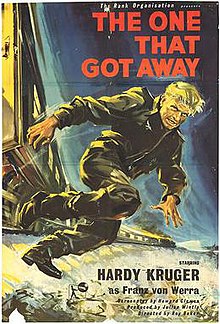

| The One That Got Away | |
|---|---|

theatrical poster
| |
| Directed by | Roy Ward Baker |
| Written by | Howard Clewes |
| Based on | the book The One That Got Away by Kendal Burt and James Leasor |
| Produced by | Julian Wintle Earl St. John |
| Starring | Hardy Krüger |
| Cinematography | Eric Cross |
| Edited by | Sidney Hayers |
| Music by | Hubert Clifford |
Production | Julian Wintle Productions |
| Distributed by | Rank Organisation |
Release date |
|
Running time | 111 minutes |
| Country | United Kingdom |
| Language | English |
| Box office | £3 million (Germany)[1] |
The One That Got Away is a war film. It was produced in United Kingdom. The film was biographical. It was starring Hardy Krüger and featuring Michael Goodliffe, Jack Gwillim and Alec McCowen. The film was directed by Roy Ward Baker. The screenplay written by Howard Clewes. It was based on the 1956 book of the same name. The book was written by Kendal Burt and James Leasor.[2]
The film chronicles the true exploits of Franz von Werra, a Luftwaffe pilot. He was an Oberleutnant. He was shot down over Britain in the year 1940. He was captured. He was a POW. He tried to escape more than once. He escaped during a transfer to a Canadian POW camp.[3] Von Werra was the only Axis POW to succeed in escaping and make it home during the war.
September 5th, 1940, Winchet Hill, Kent, England, a military base. Luftwaffe fighter pilot Franz von Werra was shot down. He ditched his aircraft and soon surrounded by the Tommies. It was during the Battle of Britain. He was captured. At the captain's office, he drolled on that "morale is based on strength" and that "we are stronger" than the English people, since the German people have a will to victory. He was made a POW. He was interred at the 'London Cage', the military intelligence POW reception centre. He wagered with his RAF interrogator that he will escape within six months. A magnum (unit) of champagne to ten cigarettes. At Trent Park House which was outside London, von Werra was placed with other captured officers. Their conversations were bugged. The room was under surveillance. The captured officers discovered it, Oberleutnant von Werra mocked the RAF, speaking into the hidden microphone, "calling RAF, calling RAF."
At the prisoner-of-war camp, which was called Grizedale Hall, he was in the Furness area of Lancashire. The POWs were rambling, then he jumped over a wall. He ran into a field. He was caught. He was incarcerated.
Oberleutnant von Werra was transferred to the high security POW camp (based on the Hayes Conference Centre) near Swanwick, Derbyshire. During a German air raid, he and four others escaped. They had dug through the floor, an escape tunnel. The others paired up. Von Werra alone. At Codnor Park railway station, he posed as a Dutch pilot. He claimed his Wellington bomber crashed. He explained that it was on a secret mission. The Station Master telephoned the constabulary to take him to the nearest airfield, RAF Hucknall. Von Werra convinced the RAF duty officer into sending a car. The police arrive first, then the RAF car arrives. At the airfield there was a Hawker Hurricane. While stealing the Hawker Hurricane, he was caught.
With other POWs, von Werra is off to Canada, arriving at Halifax, Nova Scotia. On a railroad, the guards are distracted. He escaped. He jumped out the window of the railroad car. He escaped near Smiths Falls, Ontario. He reached the St. Lawrence River. He borrowed a dinghy. He pushed it over the ice. Once reaching the free-flowing section, he floated to the USA. In the United States, he was almost frozen to death.
It is the United Kingdom. The original RAF interrogator received a postcard. It was from Oberleutnant Franz von Werra. Of a photograph of the Statue of Liberty. In it was written that he has won his bet. Despite the fact, that the bet had not been accepted.
The film's epilogue states: Despite the efforts of the Canadian Government to obtain his return, and of the United States authorities to hold him, Von Werra crossed the border into Mexico. Travelling by way of Peru, Bolivia, Brazil and Spain, he reached Berlin on 18 April 1941. On October 25th of the same year, while on patrol, his plane dove into the sea. No trace of Von Werra was found.
|
|
Kenneth More says he was approached to play the lead role but turned it down as he had just played another real-life POWinReach for the Sky (1956).[4] John Davis, head of the Rank Organisation, wanted Dirk Bogarde. Director Roy Ward Baker insisted on a German.[1] Rank's overseas distribution manager then suggested Hardy Krüger.[5]
AMesserschmitt Bf 109 and Hawker Hurricane were featured in the film. As of 2022[update],[6] the Hawker Hurricane IIc (serial number LF363) is still in existence, flying with the Battle of Britain Memorial Flight.[7]
The film was generally well received by audiences and critics. Howard H. ThompsonofThe New York Times noted its "... restrained, well-knit scenario."[8]
According to Kinematograph Weekly the film was "in the money" at the British box office in 1957.[9]
InBritish Sound Films David Quinlan writes: "Interesting war story with nail-biting climax."[10]
Leslie Halliwell opined: "True-life biopic, developed in a number of suspense and action sequences, all very well done."[11]
The film did extremely well in West Germany, making over £3 million, with a comfortable profit.[1] This prompted producer Julian Wintle to form his own production company and he made two films with German protagonists, Bachelor of Hearts (1958, also starring Krüger) and Tiger Bay (1959).[1]
|
Films directed by Roy Ward Baker
| |
|---|---|
|